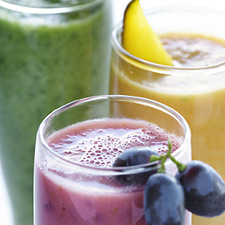
This smoothie has everything in it to boost your sexual energy…and then some!

This smoothie has everything in it to boost your sexual energy…and then some!
 You can use the power of visualization and imagery, classic mind-body techniques, to support a healthy libido. We’re all familiar with fantasizing, so I invite you to take it one step further by applying that daydream-like practice to focus on getting ready for sexual intimacy. As we age, the juices don’t always flow so spontaneously, but we can use the power of imagination to get them going!
You can use the power of visualization and imagery, classic mind-body techniques, to support a healthy libido. We’re all familiar with fantasizing, so I invite you to take it one step further by applying that daydream-like practice to focus on getting ready for sexual intimacy. As we age, the juices don’t always flow so spontaneously, but we can use the power of imagination to get them going!
Try this: Picture the place where you and your partner will be intimate. Create the scene in your mind exactly as you’d like it to be, using all of your senses. Look around in your mental room or space at the colors, the visuals, what’s on the walls or windows, the furniture, etc. Or if you’re outdoors, what are the colors and sights there? Then notice the fragrances. In your imaginary room you might want to light a fragrant candle or bring in some sweet-smelling flowers. What are the sounds? Play your favorite inner music, or perhaps there’s the sound of flowing water. Now feel the textures around and beneath you: Soft? Silky? Leafy? You decide! Create the perfect scene, and then, finally, invite your partner into your intimate and beautiful space and allow yourself to let go and enjoy!
Dr Blum is honored to be one of the facilitators with The Center for Mind-Body Medicine who has partnered with Eskenazi Health System to provide a unique and exciting program of wellness, self-care, and mutual support. Eskenazi employees will experience two separate five-day trainings in mind-body medicine and group support and the opportunity for further supervision.

A new study conducted by Harvard Medical School has found that participating in an eight-week meditation training program can have measurable effects on how the brain functions even when someone is not actively meditating. Similar to this study, we’ve been seeing a great deal of news articles in recent months discussing the benefits of meditation and are excited to see the conversation growing.
Meditation as a practice and its resultant mindfulness are incredible tools that can be applied to every walk of life. Anyone can benefit from the deepening self-awareness that comes with devoting time to yourself and your thoughts (meditating) and learning new skills like breathing techniques. Think about it- the more focused and present you are, the happier and less stressed you can be!
Which is why we’re excited to be offering a Mind-Body Skills Workshop at Blum Center for Health beginning Wednesday, January 21st. Lead by Elizabeth Greig, MSN, FNP, the group meets weekly over the course of 6 weeks and provides a supportive small environment to gently begin the journey towards self-discovery, reducing and relieving stress and creating optimal health. During the course you’ll learn a series of powerful and effective healing techniques such as meditation and breathing to help you explore life changes and well being.
We also offer weekly meditation classes on Friday mornings (what better way to start your weekend) and beginning on January 20th will be offering a Tuesday meditation class focused specifically on reducing stress. If you can’t physically make it to The Center, our Learn to Relax Guide is a great tool to get you started towards understanding more about the connection between what is happening on the outside (life!) and what is happening on the inside (your body, mind and spirit). We look forward to teaching you more about these powerful tools!

Happy, healthy 2015! With January comes the start of a new year and the opportunity to set resolutions as well as goals for the year ahead. A common thread of New Year’s resolutions often includes losing weight and becoming healthier in our mind body connection. This year we’re focusing on giving you tools that will set you up for an overall attainable healthy lifestyle plan versus a fleeting quick fix. Through group weight loss programs, mindfulness classes and healthy cooking demos, we’re confident that the knowledge and support you’ll receive will bring out your healthiest, happiest self in 2015. Here’s a look at ways you can get involved this month at Blum Center for Health!
 –Winter Fat Flush Detox: With two class offerings on Monday, January 12th, at 10-11:30 am or 6-7:30 pm, you’ll receive guided instruction on Kitchari Cleansing, a total body detox that’s perfect for winter months. You will also have the opportunity to purchase all of the ingredients to make the Kitchari, along with recipes, ghee, supplements, and a comprehensive Instruction Guide! Fresh home-made Kitchari will also be available for sale at Organic Pharmer.
–Winter Fat Flush Detox: With two class offerings on Monday, January 12th, at 10-11:30 am or 6-7:30 pm, you’ll receive guided instruction on Kitchari Cleansing, a total body detox that’s perfect for winter months. You will also have the opportunity to purchase all of the ingredients to make the Kitchari, along with recipes, ghee, supplements, and a comprehensive Instruction Guide! Fresh home-made Kitchari will also be available for sale at Organic Pharmer.
–Winter Weight Loss Group: Beginning January 26th, our 2 month Winter Weight Loss Group provides a supportive group setting for long lasting weight loss results. The group meets 4 Monday evenings from 6:00 – 7:30pm, and focuses on warming foods that help restore and boost your mitochondria, the energy producing cells that play an important role in your metabolism. Come discover which foods can improve your health and promote weight loss!
–Mind-Body Skills Groups: Eating healthy and staying active are only part of the equation. Beginning January 21st, our Mind Body Skills Group provides a supportive small group environment to gently begin the journey towards self-discovery, reducing and relieving stress and creating optimal health. You’ll learn a series of powerful and effective, research-based healing tools such as meditation and breathing to help you explore life changes, stress and well being. Anyone can benefit from the deepening self-awareness that comes from these explorations, as well as people who have a particular health or life challenge and want to understand more about the connection between what is happening on the outside (life!) and what is happening on the inside (your body, mind and spirit). Groups meet weekly from 9:00am – 10:30am over the course of 6 weeks.
 With the dry, cold air, winter is the time to eat foods that produce mucus in the body and provide a slow sustainable energy source. It is a time when the earth provides food from the fall harvest that is naturally heavier and full of protein and healthy fats. This does not mean that carbs need to be avoided in the winter, simply that the proportions are different, with a focus on soups, grains, nuts, and yes, meats, too. Remember, not all grains are the same and I always recommend eating the less inflammatory gluten-free grains, just as I recommend eating grass-fed organic beef and free-range organic poultry whenever possible.
With the dry, cold air, winter is the time to eat foods that produce mucus in the body and provide a slow sustainable energy source. It is a time when the earth provides food from the fall harvest that is naturally heavier and full of protein and healthy fats. This does not mean that carbs need to be avoided in the winter, simply that the proportions are different, with a focus on soups, grains, nuts, and yes, meats, too. Remember, not all grains are the same and I always recommend eating the less inflammatory gluten-free grains, just as I recommend eating grass-fed organic beef and free-range organic poultry whenever possible.
Vegetables continue to be important in the winter and are especially warming when eaten in soups and stews with added legumes and fat to make it even heartier. In the winter, I love to have bean soup for lunch most days. I heat it on the stove top at home, and bring it to work hot in a thermos. This is the quickest and easiest lunch and is perfect for those of you who sometimes skip or forget to eat ‘on time’ while at work.
Salads and cold-pressed, low-sugar juices are still really nourishing for you in the winter and will give you the intense levels of vitamins your body needs and might be missing because of your focus on cooked foods. Your body will really like these foods, especially after exercise when you are heated. The most important thing to remember is that, in addition to making sure there is a protein source in your salad, you should make sure to add plenty of fat, too. Don’t skimp on the dressing, and be generous with sprinkling nuts and/or seeds. This is a good time of year to add that cheese, whether dairy (if you can eat dairy) or a nut cheese like almond cheese.
If you choose to do a juice cleanse during the winter, make sure the daily program has lots of fat and protein, too. I designed the cleanse program at Organic Pharmer to be nutritionally sound in this way, and work for all the seasons. Choose the cleanse with the highest daily fat and protein. I recommend Power Play, Reboot, and Liver Love.
 Your body instinctively thrives when it takes its cue from nature and follows its own rhythm. During winter, Nature is at rest, and so it is for you: the time to turn your attention inward, seeking warmth and comfort at home with loved ones.
Your body instinctively thrives when it takes its cue from nature and follows its own rhythm. During winter, Nature is at rest, and so it is for you: the time to turn your attention inward, seeking warmth and comfort at home with loved ones.
The cold and damp weather is also when your body intuitively craves more warm, cooked and satisfying foods that are higher in protein and fibrous carbohydrates. It’s also a great time to pull out the slow cooker or your Dutch oven and gather your favorite ingredients for a nourishing meal.
Here’s a list of the foods to incorporate into your winter food plan:
Remember, because days are shorter, you may be less active. Therefore, take care not to increase your food intake too much during the winter months, as it is easy to gain unwanted pounds.